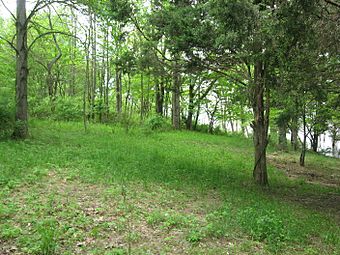Kappa V Archaeological Site facts for kids
Quick facts for kids |
|
|
Kappa V Archeological Site (12MO301)
|
|
 |
|
| Area | 0.3 acres (0.12 ha) |
|---|---|
| NRHP reference No. | 86000630 |
| Added to NRHP | March 31, 1986 |
Kappa V is an important archaeological site located in the southern part of Indiana, a state in the United States. This site is like a special outdoor museum. It holds clues about people who lived there long, long ago.
Because of its historical importance, Kappa V was added to the National Register of Historic Places in 1986. This happened just one week before three other nearby sites, called Axsom Branch, Epsilon II, and Refuge #7, were also added.
Contents
What is an Archaeological Site?
An archaeological site is a place where people find evidence of past human activity. This evidence can include tools, pottery, old buildings, or even ancient campfires. Archaeologists are like detectives. They study these clues to learn about how people lived many centuries ago.
Why is Kappa V Important?
The Kappa V site is special because it helps us understand early human history in Indiana. It shows us how people lived, hunted, and gathered food. It also reveals how they changed their ways of life over time.
Discovering Ancient Life
At Kappa V, archaeologists have found signs of two main time periods. These are the Archaic period and the Woodland period. Each period tells a different story about the people who called this area home.
The Archaic Period
The Archaic period in North America lasted for thousands of years. It was a time when people lived by hunting animals and gathering wild plants. They moved around a lot to find food.
Life in the Archaic Period
People during the Archaic period were very skilled. They made tools from stone and bone. These tools helped them hunt deer, small animals, and birds. They also used tools to prepare plants for eating.
What Archaeologists Find
At sites like Kappa V, archaeologists might find spear points from the Archaic period. They might also find grinding stones used to prepare seeds. These items help us imagine their daily lives.
The Woodland Period
The Woodland period came after the Archaic period. During this time, people started to live in more settled villages. They began to grow some of their own food, like corn and squash.
Changes in the Woodland Period
A big change in the Woodland period was the invention of pottery. People used clay to make pots for cooking and storing food. They also built mounds for burials or ceremonies.
Clues from the Woodland Period
At Kappa V, archaeologists might uncover pieces of broken pottery. They might also find different types of arrowheads. These discoveries show how people's lives became more complex.
Protecting Kappa V
The Kappa V site is protected because it is so valuable. It helps us connect with the past. By studying these sites, we learn about the first people who lived in Indiana.
Why We Protect Sites
Protecting archaeological sites ensures that future generations can also learn from them. It's like preserving a very old book. Each piece of evidence tells a part of the story.
How Sites Are Protected
The National Register of Historic Places helps protect important sites like Kappa V. This means the site is recognized for its historical value. It helps prevent damage and encourages careful study.

